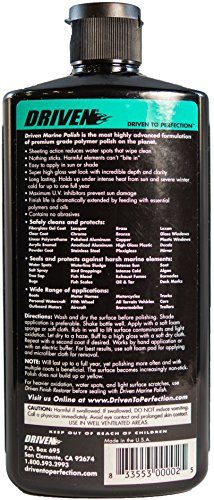
When your boat starts to fade and lose its shine, it’s time for some polishing. Of course, if you wish to restore the hull to its former glory, you’ll need to use the best boat polish for your type of boat. This article guides you through the selection process and makes it easy to pick out the best marine polish for fiberglass, aluminum, or any other material.
Most of us take great pride in our boats, and no one likes looking at their vessel all chalked and run-down. With the help of our boat polish reviews and buying guide below, you’ll have a great-looking, glossy boat year-round.
OUR TOP PICK
3M Marine Aluminum Restorer
- Stand Out Features - Why We Love It
- Excellent results on all aluminum surfaces
- Completely removes heavy oxidation and chalking
- Restores the original luster (high-gloss shine)
- Easy to apply by hand or with a boat buffer
Volume: 18 ounces
Surfaces: Aluminum
UV-resistance: Yes
BEST VALUE
Flitz Multi-Purpose Cleaner
- Stand Out Features - Why We Love It
- Multi-purpose formula for using on and off the boat
- Potent against heavy oxidation, tarnish, rust, and water stains
- Completely non-toxic and non-flammable (safe to use)
- Leaves a brilliant shine after buffing
Volume: 7.6 ounces
Surfaces: Metal, Plastic, Fiberglass
UV-resistance: No
Meguiar’s M4516 Gloss Enhancer

- Stand Out Features - Why We Love It
- Restores gloss on both painted surfaces and fiberglass
- Contains oils that nourish the gel coat and improve durability
- Fantastic for returning gloss to darker-colored boats
- Convenient bottle and very easy application
Volume: 16 ounces
Surfaces: Fiberglass, Painted Surfaces
UV-resistance: No
- Stand Out Features - Why We Love It
- Paste consistency for easier scrubbing and polishing
- Effective on almost any surface (painted or non-painted)
- Eco-friendly formula (non-toxic and non-flammable)
- Anti-tarnish protection lasts for up to 6 months
Volume: 2 pounds
Surfaces: Metal, Plastic, Fiberglass, Aluminum, Sterling Silver
UV-resistance: No
Driven Marine

- Stand Out Features - Why We Love It
- Leaves a coating that repels dirt and water stains
- Gives a high gloss with very little effort
- Fantastic protection against UV damage and fading
- Stays active and prevents oxidation for up to a year
Volume: 16 ounces
Surfaces: Fiberglass, Painted Surfaces, Aluminum, Steel, Plexiglass
UV-resistance: Yes
- Stand Out Features - Why We Love It
- Easily removes swirl marks and surface scratches
- Blocks UV rays to stop the fading
- Doesn’t require hard rubbing (works by hand too)
- Effective for more than a year with two coatings
Volume: 16oz and 1 gallon
Surfaces: Fiberglass, Aluminum, Painted Surfaces
UV-resistance: Yes
Gel Coat Labs One-Step Gel Coat Sealant

- Stand Out Features - Why We Love It
- Excellent option for restoring and cleaning fiberglass boats
- Micro-polish formula leaves a mirror-like shine
- Safe for applying in direct sunlight
- Boosted by Polycharger for improved durability
Volume: 16 ounces
Surfaces: Gel Coat (Fiberglass)
UV-resistance: No
How To Choose The Best Marine Polish – Buying Guide

Types of Boat Polish
The main task of a boat polish is to remove a very thin layer with pits and imperfections in it. This way, the surface gets smooth again and looks much better. While all polishes have the same job, there are differences in ingredients based on the hull material.
Fiberglass (gel coat): Fiberglass boats have a gel coat on the surface, responsible for protection and the boat’s shiny new look. Broadly speaking, the best boat polish for fiberglass is often also a restorer (Gel Coat Labs polish, for example), with the ability to fill in the small imperfections so the surface is flat and glossy again.
Aluminum: If not maintained properly, aluminum is prone to oxidation (makes your boat look a lot worse). A good boat polish for aluminum (like the 3M Marine) will completely remove oxidation and chalking, leaving your boat looking like new.
Multi-purpose: These polishes are the jack of all trades and do a good job regardless of the surface. They are usually less abrasive than metal polishes, but achieve a good shine nonetheless. A good example is the Flitz Multi-Purpose boat polish.
You might also like: How To Clean Boat Hull: Easy Step by Step Guide
Ease of Use
Polishing a boat can take a very long time, so it’s a good idea to consider how easy a product is to use. As you’ve had the chance to see, marine polishes come as a liquid and a paste.
Regardless of which one you get, it needs to be rubbed in properly. While all products can be applied with a boat buffer, we think that it’s a big plus if you can rub it in by hand too.
Another thing worth considering is whether a single coating is enough, or the polish requires multiple coatings to work (takes much more time). Of course, always make good preparations beforehand so you can polish boat as easily as possible.
UV Protection and Weather-Resistance
Since your boat will sit in the water and be exposed to the sun for a long time, it needs to have good surface protection. A high-quality marine polish will provide reliable UV protection, shielding your vessel against fading and sun damage. Also, it will form a protective barrier that will protect it from water exposure.
Durability and Performance
It’s not easy to polish the entire surface, so you want the coating to last as long as possible. If applied properly, high-quality products can remain on the surface for over a year.
It’s also important that it remains effective the entire time (protect the hull and retain high gloss). In our opinion, giving a bit more money is worth it if the polish will have a better and more durable effect.
FAQs

Q: Can I Use Car Wax On My Boat?
Yes you can, but it won’t be as effective. The two types of waxes are made for different applications, so a car wax on a boat might not give you the results you’re expecting. The best boat wax is made to be in constant contact with water and has a much better sun protection, which is why we advise that you always get a boat-specific product.
Q: What Should I Do About Waxing My Boat If It Has Some Oxidation On It?
Oxidation is a problem, but it can be easily cured with the right boat wax. You just need the right product that removes the oxidated layer (most aluminum-specific products we featured can do this). As for prevention, make sure to polish your boat regularly.
Q: What Is The Difference Between Marine Sealants and Boat Waxes?
Waxes and sealants are generally used for the same job – protecting your boat from the elements. The main difference between the two is in their ingredients. Wax is generally made with natural ingredients, whereas a sealant is fully synthetic.
Q: How to Restore Fiberglass Finish On A Boat?
You can restore the looks of your fiberglass boat by cleaning, polishing, and waxing the surface. You’ll get even better results if you use gel coat-specific products like 3M Marine fiberglass restorer and wax or Gel Coat Labs gelcoat cleaner. In addition, both polishing and waxing will be more efficient with a boat buffer.
Globo Surf Overview
Polishing your boat isn’t just about restoring its shine – it’s about protection as well. A great marine polish will shield the hull from UV rays and salt water, all while giving your boat a glossy and fresh look. Hopefully, our guide and product selection have helped you make your decision, so you can be proud of how your boat looks.







